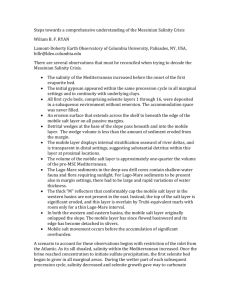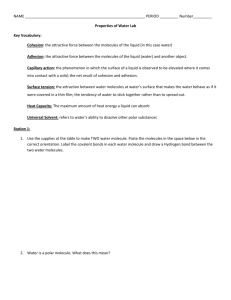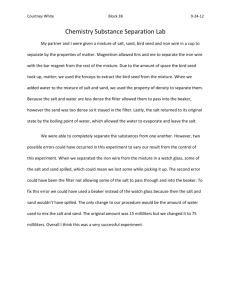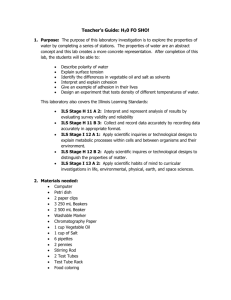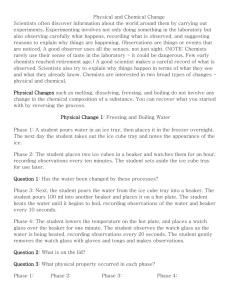Lab1_Salt_solubility
advertisement
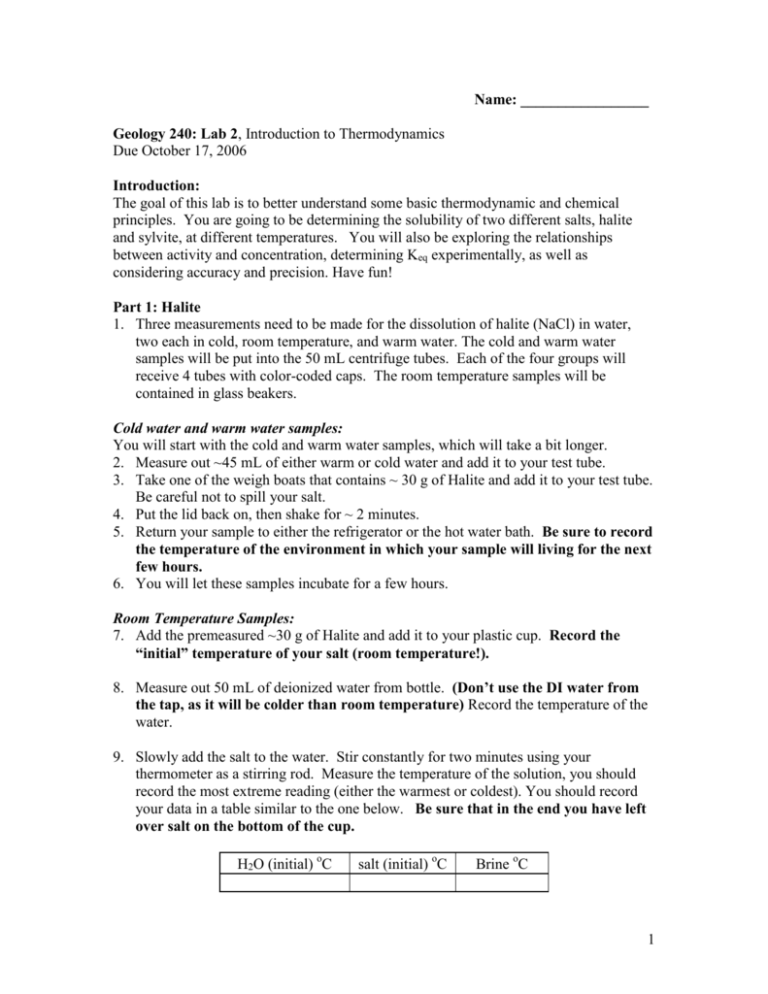
Name: _________________ Geology 240: Lab 2, Introduction to Thermodynamics Due October 17, 2006 Introduction: The goal of this lab is to better understand some basic thermodynamic and chemical principles. You are going to be determining the solubility of two different salts, halite and sylvite, at different temperatures. You will also be exploring the relationships between activity and concentration, determining Keq experimentally, as well as considering accuracy and precision. Have fun! Part 1: Halite 1. Three measurements need to be made for the dissolution of halite (NaCl) in water, two each in cold, room temperature, and warm water. The cold and warm water samples will be put into the 50 mL centrifuge tubes. Each of the four groups will receive 4 tubes with color-coded caps. The room temperature samples will be contained in glass beakers. Cold water and warm water samples: You will start with the cold and warm water samples, which will take a bit longer. 2. Measure out ~45 mL of either warm or cold water and add it to your test tube. 3. Take one of the weigh boats that contains ~ 30 g of Halite and add it to your test tube. Be careful not to spill your salt. 4. Put the lid back on, then shake for ~ 2 minutes. 5. Return your sample to either the refrigerator or the hot water bath. Be sure to record the temperature of the environment in which your sample will living for the next few hours. 6. You will let these samples incubate for a few hours. Room Temperature Samples: 7. Add the premeasured ~30 g of Halite and add it to your plastic cup. Record the “initial” temperature of your salt (room temperature!). 8. Measure out 50 mL of deionized water from bottle. (Don’t use the DI water from the tap, as it will be colder than room temperature) Record the temperature of the water. 9. Slowly add the salt to the water. Stir constantly for two minutes using your thermometer as a stirring rod. Measure the temperature of the solution, you should record the most extreme reading (either the warmest or coldest). You should record your data in a table similar to the one below. Be sure that in the end you have left over salt on the bottom of the cup. H2O (initial) oC salt (initial) oC Brine oC 1 10. What happened when “room temperature” salt was added to “room temperature” water? Did the temperature change, and if so, in what direction? 11. Continue to stir your solution for 2 minutes. Carefully lift out the plastic cup. You should still have salt crystals on the bottom of the cup. If not, ask for help -- you want to be sure your solution is saturated with salt before you proceed! The following steps should be followed for both all three of your Halite samples. 12. Once you are sure your solution is saturated and the temperature of the solution is relatively stable: a. weigh one of the empty 50 ml glass beakers (be sure your beaker is labeled before you weigh it!) b. measure the temperature of the solution c. carefully pipette ~10 ml of brine into the glass beaker. Be careful not to let any salt crystals into the small beaker!! i. Pour the remaining solution, salt crystals and all, into the container labeled: “Halite saturated solution” d. weigh the beaker containing the solution. e. place the beaker on one of the hot plates and let the water evaporate, be careful it doesn’t boil and splatter!!! f. when dry, let the beaker cool to room temperature and re-weigh. g. calculate the composition of the solution in terms of Molarity, which is moles/liter. h. CLEAN OUT THE BEAKER – (you will be penalized point for failing to clean up after yourself!!) ****************************************************************** Temp Empty Bkr (g) Bkr+Sol Dry Solution (g) Bkr (g) (g) Salt (g) H2O (g) H2O (L) ***************************************************************** 2 Part 2: Sylvite You will be repeating many of the same steps you took in part one. This time however, you do not need to use different temperature water. You will run these samples in duplicate again. Room Temperature Samples: 13. Add the premeasured ~15 g of Sylvite and add it to your plastic cup. Record the “initial” temperature of your salt (room temperature!). 14. Measure out 50 mL of deionized water from bottle. (Don’t use the DI water from the tap, as it will be colder than room temperature) Record the temperature of the water. 15. Slowly add the salt to the water. Stir constantly for two minutes using your thermometer as a stirring rod. Measure the temperature of the solution, you should record the most extreme reading (either the warmest or coldest). You should record your data in a table similar to the one below. Be sure that in the end you have left over salt on the bottom of the cup. H2O (initial) oC salt (initial) oC Brine oC 16. What happened when “room temperature” salt was added to “room temperature” water? Did the temperature change, and if so, in what direction? How did this compare to the Halite? 17. Continue to stir your solution for 2 minutes. Carefully lift out the plastic cup. You should still have salt crystals on the bottom of the cup. If not, ask for help -- you want to be sure your solution is saturated with salt before you proceed! 18. Once you are sure your solution is saturated and the temperature of the solution is relatively stable: a. weigh one of the empty 50 ml glass beakers (be sure your beaker is labeled before you weigh it!) b. measure the temperature of the solution c. carefully pipette ~20 ml of brine into the glass beaker. Be careful not to let any salt crystals into the small beaker!! i. Pour the remaining solution, salt crystals and all, into the container labeled: “Sylvite saturated solution” d. weigh the beaker containing the solution. 3 e. place the beaker on one of the hot plates and let the water evaporate, be careful it doesn’t boil and splatter!!! f. when dry, let the beaker cool to room temperature and re-weigh. g. calculate the composition of the solution in terms of Molarity, which is moles/liter. h. CLEAN OUT THE BEAKER – (you will be penalized point for failing to clean up after yourself!!) ****************************************************************** Temp Empty Bkr (g) Bkr+Sol Dry Solution (g) Bkr (g) (g) Salt (g) H2O (g) H2O (L) ***************************************************************** Your write up: Share your data!! You will receive (from me) an email with an excel spreadsheet that you should input your data into. I want all data emailed back to me by 8 am Thursday. I will then compile the data and send it back to all of you. Your write up for this lab should be typed and should include: a. Methodology, or a summary of what you did. i. Include a summary of what you did in each section. b. Calculations (we will be covering this material in class on Friday) i. Determine the Keq at saturation for both halite and sylvite at room temperature using the data from Appendix II in Eby. ii. Calculate how much Na+, K+, and Cl- should be in solution for parts 1 and 2 based upon the thermodynamic data. 1. You will need to use the van’t Hoff equation to account for the different temperatures iii. Calculate the enthalpy of the reactions from parts 1 and 2. iv. Determine the activity coefficient of the solutions at room temperature. Report which equation/method was used, along with a justification for using that equation. c. Results, including: i. A graphical representation of the data that was collected. These graphical representations should also include the calculated data as a separate data set. You should produce at least two graphs: 1. A comparison of temperature for your halite samples 2. A comparison of halite and sylvite at room temperature. ii. A brief discussion of the influence of temperature on solubility of these salts. iii. Compare your collected data to the calculations above in part (b). iv. Consider the accuracy and precision of your measurements. Included in this discussion should be what some of the sources of error may be. 4 Some Important Lab Procedures for the Salts Lab Using the Auto-pipettes The auto-pipettes are a remarkably handy tool in the lab. Some things to take note of: 1) Is the tip clean? In this lab you don’t need to use a brand new tip for each experiment, but you do want to make sure that there isn’t left over solution (at least not much) left in the tip. In some cases you need to be sure to use a clean new tip for each measurement. 2) Is the tip on well? 3) Slowly depress the thumb button until you get to the first stop point. 4) Insert the tip into the solution. You want to be sure that you are into the solution far enough that you won’t suck air, but you also don’t want to be all the way at the bottom where you might suck up crystals on the bottom. 5) SLOWLY release the thumb button, the tip should fill up with the solution. 6) Empty the solution into your beaker by depressing the thumb button all the way (this should be further than you depressed before). You may want to practice with the auto-pipette before you start. 5


